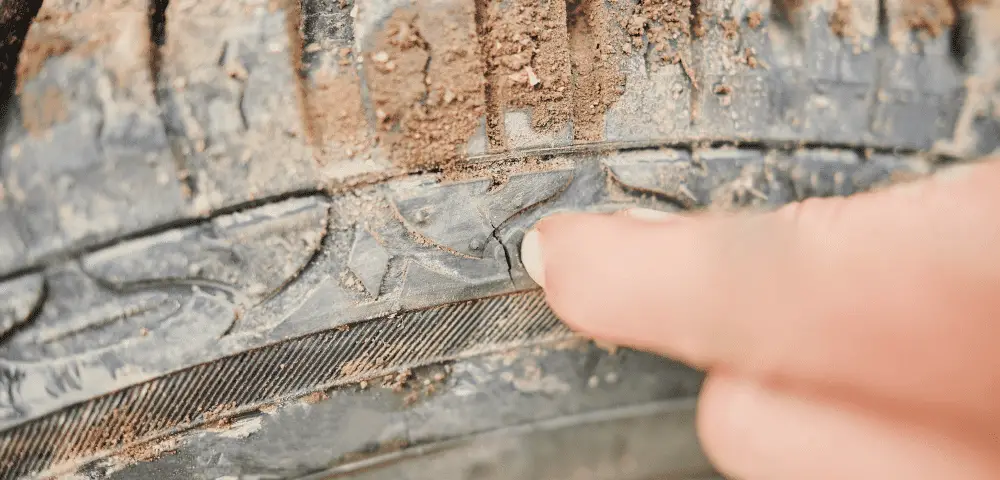When a vehicle is on the road, the tires go through a lot of wear and tear. Tires can easily get cracked due to the friction from the road, standing stationary for months and years, compression and expansion due to weather changes.
These conditions not only cause damage to the tires but keeps your safety at stake as well!
Whether you are a car lover or not, you need to take care of the dry rot tires and acknowledge when are cracks in the tire sidewall are unsafe. Here are the things that you should know to keep your tires safe.
Dry Rot Tires Explained!
Dry Rot Tire, widely known as tire’s sidewall cracking. As the term defines itself, Dry Rot Tire means the occurrence of cracks in the tire rubber. Severe dry rot tire can cause cracks on the edges of the tire’s treads.
Consequently, your car’s handling, tire’s road grip, and firmness of drive is compromised.
From a layman’s understanding, using dried-out tires causes cracks in the tires, consequently rotting them.
It is essential to look for the signs for when are cracks in the tire sidewall are unsafe because if you can observe the occurrence of cracks in its initial stages, there can be repairs done. But, once they increase, there are no other options left than replacement of tires.
To keep your vehicle safe and running with smooth traction, you need to stop the rot!
When Are Cracks in Tire Sidewall Unsafe?
“Drive safe because life has no spare wheel!”
As tire age, they start developing cracks, either superficial or deep.
The superficial cracks are usually catered to by applying tire sealants and anti-aging chemicals to prolong the life of tires.
However, if the deeper cracks on the tire sidewall go unnoticed, they penetrate to the inner structure and can cause a complete blowout while you are speed driving, a risk that can be fatal and no one would want to take.
Everyday use of the vehicle calls for constant tire checks, which increases the possibility of observing the cracks at their initial stage. Regular tire detailing and repairs helps you counter the severe consequences of tire sidewall cracks.
But if you own a sports car and seldom drive it or there is a campervan in your garage for family trips that are used once or twice a year, you need to be concerned because cracks in tire sidewall can easily encapsulate the deeper layers if it has been sitting static for long.
Signs of Cracks in Tires You Need to Look Out For!
Even if you are a new vehicle owner, here are some obvious signs that you need to watch out for so you know when the tire sidewall cracking is unsafe.
- Dull, dry, and brittle tires without any moisture.
- Tire’s rubber chipping or falling off.
- Cracks on the outer edges of the tire treads.
- Isolated cracks on the sidewalls or spread around the hubcap.
- The faded color and dull appearance of the tire.
- Fleecing of the car, vibration while driving, and weird noises.
Causes of Tire Cracking
“Know your tires better to drive better and safer!”
Minor cracks can be repaired, but dry rot tires cannot. To save you money and the hassle, we have gathered a list of the signs and causes of tire cracking.
- Keep the tires away from excessive sunlight and UV rays.
- Keep the abrasive or corrosive substances like motor oil, industrial cleaning agents at bay from the tires.
- Avoid driving in drastic weather changes.
- Check for the air pressure, avoid under-or over-inflation.
- Keep the tires away from electrical equipment that generates ozone.
One of the best ways to keep your tire’s health intact is to maintain it with regular detailing and care.
Preventing Cracks in Tires. How Should You?
As they say, “precaution is better than cure,” just like any disease can be prevented with due care, the same is the case with the tires, as due care can keep you safe from severe damage.
Here is a comprehensive step-by-step guide to save your tires from drying rot.
- Regular inspections. Make it a habit to check the sidewall and the tire before taking the vehicle for a drive.
- Avoid the sun. UV rays are nobody’s friend. Always park your car in the shade, away from the sun, to save them from dry rot.
- Upkeep the tire’s maintenance. To prevent cracking in tires, clean the tires regularly with a washcloth and some dish soap to wipe off any dangerous chemicals or substances from the tires’ surface.
- Avoid harmful products. If you love to clean and protect your tires with available market products, ensure that you use tire-friendly ones.
- Tires pressure. Always keep the air pressure in the tires at optimum.
- Manage the carload. Avoid overloading your vehicle with people or goods, as excessive pressure on tires makes the sidewall crack.
- Static care. If your vehicle is going to be stationary for a longer period, park it out of the sun, take off the tires and make the vehicle stable on the jack stands if possible; if not, take the vehicle for a drive whenever possible, remove all the weight from the vehicle before you park it.
What to Do About Your Cracked Tires?
Even with all the precautions and maintenance, the tires are bound to crack at some point because vehicle usage is unavoidable, and so are the harmful conditions.
If the cracks are superficial, take the vehicle to a repair shop, they may preserve the tire with a sealant.
However, if the sidewall cracks are deep- a dry rot tire, the tire needs to be replaced. Whichever the case, it is best to go for professional guidance.
Take care of your tires in the garage, so they take care of you on the road!


